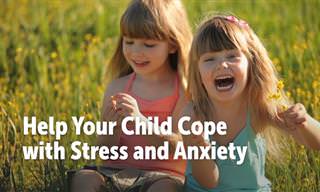



These 5 Tips Will Help Your Child Cope With Anxiety
Here are some ways to help your children manage their stress levels that will make their, and your lives much easier.

Should Children Have Caffeine? Here's Our Complete Answer
This article asks: should kids have caffeine, and how much is too much?

The Risks of Child Abduction: What You Need to Know
One viral video has highlighted how susceptible kids are to child abduction from strangers. But how likely is this? And what can you do to prevent it?

How to Protect Your Kids and Grandkids This Summer
Many parents are unsure how best to protect their kids from the sun. Here are 10 common myths about sunscreen.

Study: The Effect 40 Minutes Have on Children
Let's explore the details of this research and the opinions of other experts in this domain.

How Should Your Child Act With Strangers? Read This!
Take steps to ensure your child's safety with this guide.

10 Things Scientifically Proven to Make Children Smarter
10 scientifically proven ways to make your children smarter. All easily done at home.

7 Questions That'll Teach You a Lot About a Child
Here are 7 such questions that can help you as parents better understand your children, identify possible issues, and strengthen the bond between you.

If a Child Lives with Praise, This Is What He'll Learn...
How should we go about raising our children to be strong, independent and certain of themselves?

9 Things Every Loving Mother Does for Her Children
The following 9 things clarify exactly how much mothers do for their children without them always being aware of it... ..

10 Simple Games To Play With Children Anywhere You Go
Do you dread being asked "are we there yet?" Try these simple games and you'll have your young ones entertained for hours upon hours!

Spot the 9 Signs of Harmful Family Dynamics
Identify the problematic dynamic in your family from the following 9 types, and note that there may be more than one such dynamic present in the

Hilarious: Kids, Chaos, and Kodak Moments
The 17 parents in the following pictures should be awarded the best parent award, if only for the way they deal with their silly kids!

21 Super Creative Ideas For Fun Activities With Kids!
You don't have to be young to help children develop with these 21 fun activities. See for yourself and help that little darling grow up strong and happy!

22 Photos That Show Children Do Take After Their Parents
It's truly a joy to see that a child resembles their parent or grandparent. It's especially fun to compare photos of these family members when the same age!
 2:41
2:41
Here's Why Children's Drawings Are So Important for Us All
This informative video explains why children's drawings are so important for their own development, as well as for the advancement of society as a whole.

99 Ways to Make Sure a Marriage Withstands the Test of Time
if you want a rock solid marriage, one that will go the long haul - Read these words of advice carefully, and write them on your heart!

12 Incredibly Sweet Signs That Your Baby Loves You
Babies may not know how to speak, but that doesn't mean that they do not know how to express love in a variety of very sweet and surprising ways.

8 Things You’re Doing That Are Spoiling Your Child
The desire to help our children and keep them happy all the time may make them spoiled, so avoid it by following these 8 tips!

The Hidden Impact of Growing Up with an Eggshell Parent
Were you were raised by an eggshell parent? Watch out for these signs.

These 11 Phrases Mean the World to Your Adult Kids
Want a better relationship with your adult children? Say these things to them.

How to Prepare Kids Starting at a New School
we've divided our tips into three parts: before, during, and after the transition, to help your children prepare and adapt to new environments more smoothly.

What Does It Mean to Be a True Friend? A Beautiful Answer
Very few things in this world are as cherished and precious as a true friend is! This heartwarming video does its best to explain why.

What is the Difference Between Asperger's and Autism?
In the following article, you will understand what it is, get to know the main syndromes on the broad spectrum of autism and related terms, and learn whether there is a difference between autism and Asperger's syndrome.

How We Might be Giving Our Children Bad Sleeping Habits
To help you understand exactly what you’re doing wrong and what you should be doing, we have some tips from pediatricians that will help ensure every child's age.

These 10 Tips are Proven to Help Raise Successful Children
We all want to raise successful children, but there are many theories about how to do it. Here are the 10 tips from psychologists, researchers, and consultants.

Marriage: 7 Fascinating Studies We Should All Read
7 different studies that shed some light on marriage, and perhaps offer insights and tips that will help you understand your own relationship better.

How to Practice Self-Care When Supporting a Sick Spouse
we decided to help you with 8 expert tips, each of which will help you cope with the changes life has brought to your relationship with an ill partner.

Introducing the Tibetan Method of Raising Children
A unique method of raising kids inspired by the Tibetans.

Guide: When to Allow Children to Use Beauty Products
Let's understand when your children can (and maybe should) start using cosmetic products and what they can incorporate into their skincare routine according to their age.

15 Tricks Parents Came Up With We'd Like to Share With You
We found some great advice from parents on Reddit, and decided to share with you the best 15!

8 Warning Signs in Teens a Parent Should Watch Out For
we've gathered 8 behaviors you should know to fully and correctly assess the state of your children.

These 10 Tips Will Help You Raise Happy and Responsible Kids
Raising kids isn't easy, especially if we want them to be responsible and happy. These 10 tips might make the task a little easier!

Improve Your Child's Life By Teaching Them These 15 Things
15 important insights about approach, effort, and the importance of choosing friends, and many more essential things that your children should know.

Important: How to Tell if a Child is Being Bullied!
Know a child who is being bullied or is doing the bullying? Read through this guide.

Babies Are Capable of Far More Than Most People Imagine!
Babies are far more than just wonderful bundles of joy, as these fascinating scientific findings have proven.

5 Scientific Reasons Why Kids Need Cuddles Every Day
Scientists found that hugging plays a vital role in a child’s brain development, offers stress relief, and may even change a baby’s genes. Read on to learn more...

25 Tips for Better Parenthood All Parents Should Know
In this article, we've gathered 25 simple and effective tips to help you become better parents.

If You Have a Strong-Willed Child, We Have 6 Tips for You
Children can be strong-willed, some even innately stubborn - but before your home becomes a battleground, try out the following 6 tips...

Screens and Kids: The Risks We Don't Consider
Teenagers who report feeling addicted to their mobile phones are at a higher risk of suicidal thoughts and behaviors," says Dr. Zeeshan Khan, a psychiatrist who was not involved in the study.

Darling Child, Here are 8 ‘Sorrys’ I Meant to Tell You
Dear child, I love you, I always have and I always will, but there are many things I should apologize for. Here are 8 of my 'sorrys'.

This Photo Competition Will Remind You of Your Childhood
This photo competition proves that children don't need photos to have fun!

8 Methods of Limiting Your Children's Phone Time
If you feel that your child is spending too much time staring at the smartphone in their hand, the following guide is for you.

Some Good Advice for Teaching Your Kids How to Learn
Our children learn a lot in school, but some have a hard time studying, task solving, reading instructions or summarizing texts. These 10 tips can help...

Help Strengthen Your Child's Immune System With These Tips
As parents, we’re always concerned about cold and flu season. Learn how to identify signs of a weak immune system, and 10 ways to strengthen it.

This Devoted Dad Has Some Words to Share....
Michael Mitchell is a devoted American father who collects tips from various fathers about raising kids, and these are some of his most interesting!

8 Tips for Creating Emotional Security in Relationships
Whether you feel emotionally secure in your relationship or not, it's important that you know the 8 ways that you can create it for you and your partner...
To enable your Ad-Free Subscription, please fill the fields below
Your subscription was successful, now you can enjoy an ad-free experience!! Note: To make sure you get no ads, please make sure to log in to your account. If you are logged in already, then refresh the page. The subscription can be cancelled at any time.


